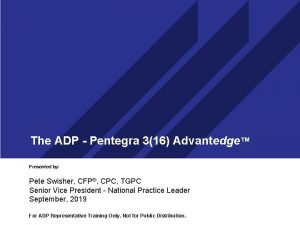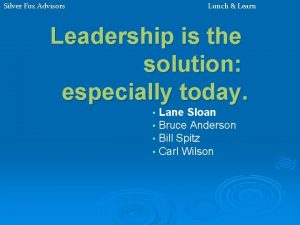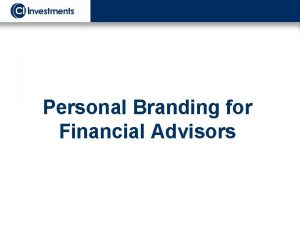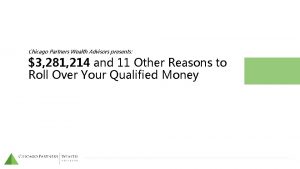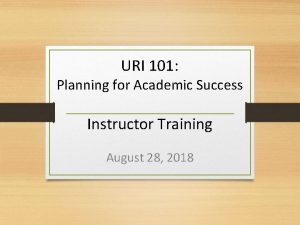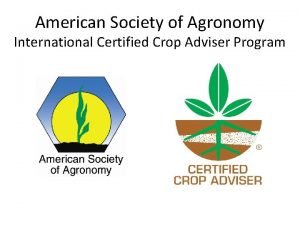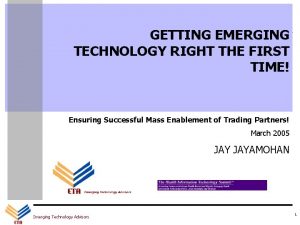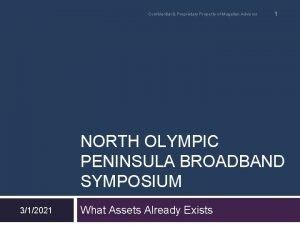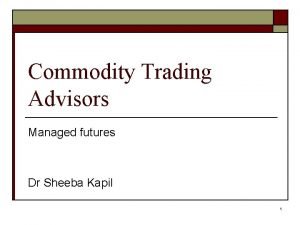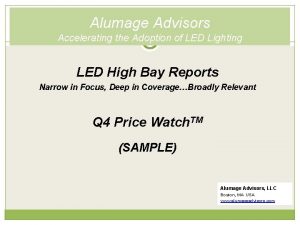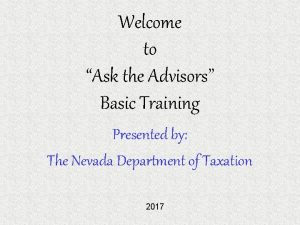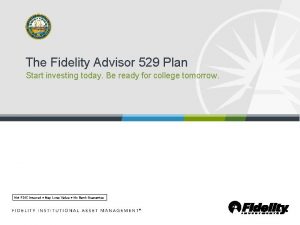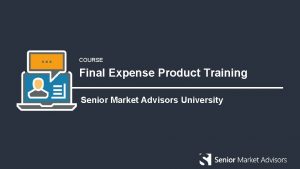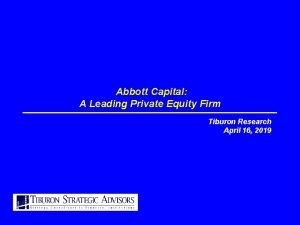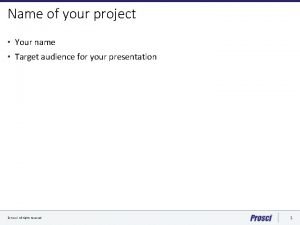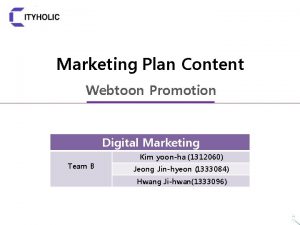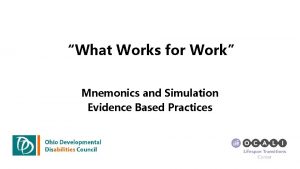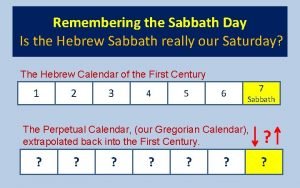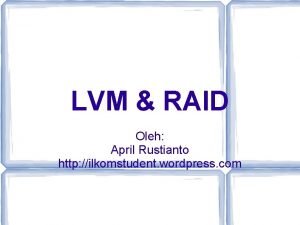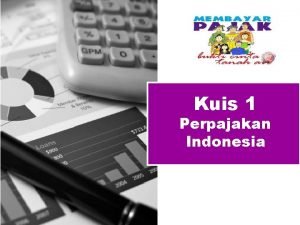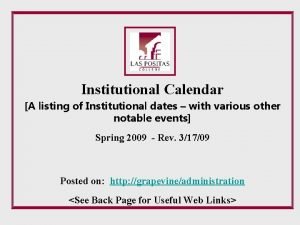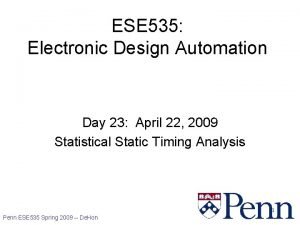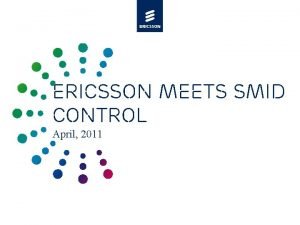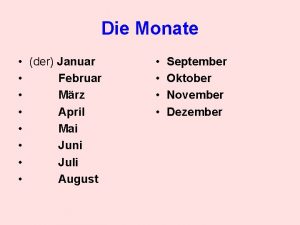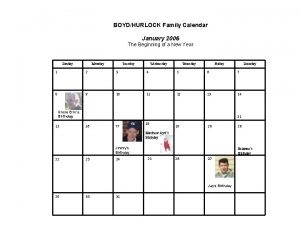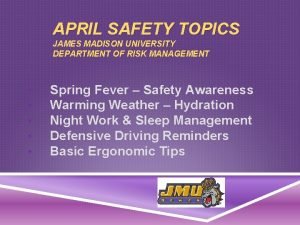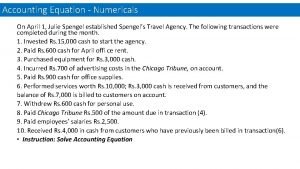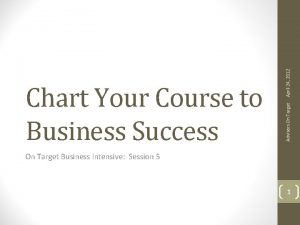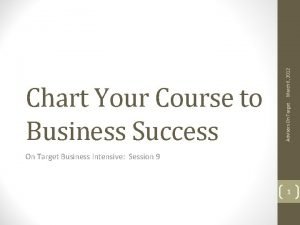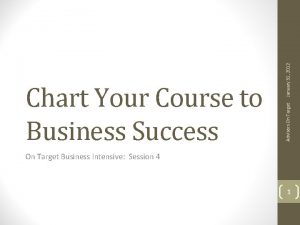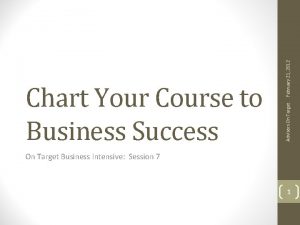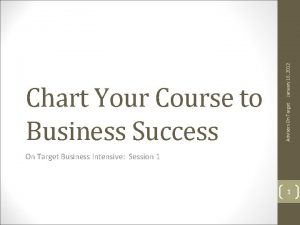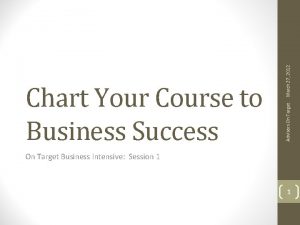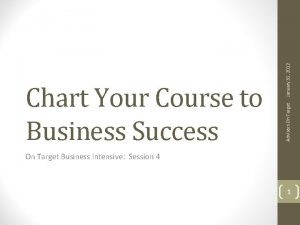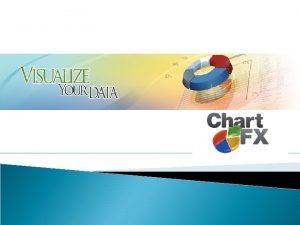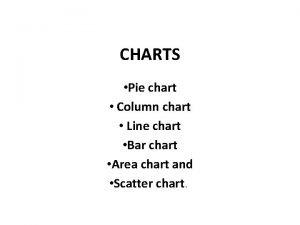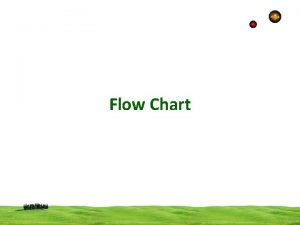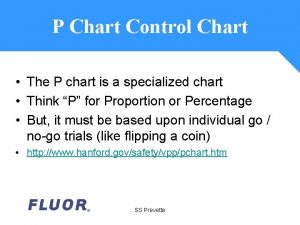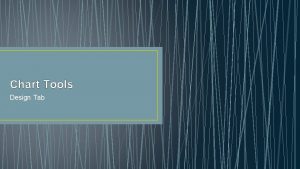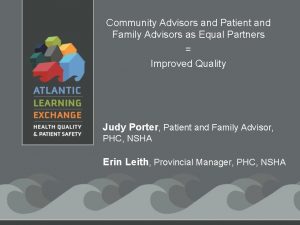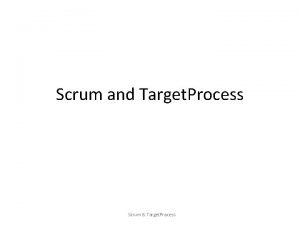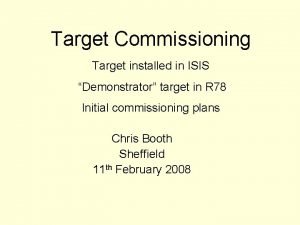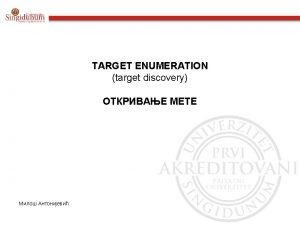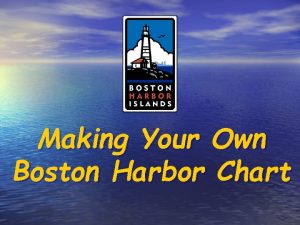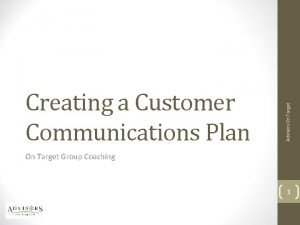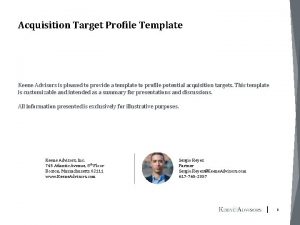April 10 2012 Advisors On Target Chart Your































































- Slides: 63

April 10, 2012 Advisors On Target Chart Your Course to Business Success On Target Business Intensive: Session 3 1

Implementation Steps • Session 1 • Create a working draft of your Mission Statement • Create a working draft of your 1 and 5 year Vision • Answer the 10 questions on the handout • Session 2 • Review your own financial statements and chart of accounts with what you learned in Session 2 • Additional activities • Values Exercise • Business Diagnostic Assessment 2

Profit Planning How to Increase Your Bottom Line 3

Your Business is an Investment to Make Money To do this, you must simultaneously increase three things: • Net Profit • Cash flow • Return on Investment (ROI) 4

How To Calculate Profit Margins • Gross Profit Margin (GP%) is profit derived from work produced divided by Gross Revenue Gross Profit Margin = (Gross Profit/Revenue)% • Net Profit Margin (NP%) is after-tax net profit divided by Gross Revenue Net Profit Margin = (Net Profit/Revenue)% 5

Key Profit Drivers • Work with these Key Profit • Price Drivers to improve • Volume of sales profitability • Variable costs • Focus on the areas where most potential increase in • Fixed costs profit is possible 6

Pricing Strategies • You can increase profit by increasing price as long as you don’t lose so much business that it reduces your net profit • You can increase profit by decreasing price as long as you increase volume enough to achieve your net profit 7

How Much Additional Volume Do I Need If I Cut My Price? Price Decrease Volume Increase To Give Same GP 8

Discount Price by 10% 9

What Volume Can I Afford To Lose If I Increase My Price? Price Increase Volume Decrease To Give Same GP 10

Increase Price by 8% 11

Cost Strategies • Increase Gross Profit by reducing Direct Costs • Labor • Materials • Keep Variable costs equal or below the rate of increase in sales revenue • Achieve greater productivity from resources that are financed by Overhead (Fixed) Costs 12

Cost Definitions § Direct Costs: Costs directly related to the production of revenue. § Variable Costs: Costs that can vary directly with sales revenue. Generally related to production but not a direct job cost § Fixed Costs: Costs that are incurred whether or not any sales are made. § Overhead (General & Administrative) Costs: These costs are generally fixed but some may be variable as well 13

Increase Gross Profit Margin To improve the Gross profit margin you need to work on these drivers: • Pricing & Estimating • Material Costs • Labor Costs • Production / service delivery processes • Customer relationships • Team Skills and Development 14

Lower your direct costs and Increase your gross profit • Decrease Cost of Labor • Decrease average wage on crews • Increase efficiency – bring jobs in on time • Decrease Cost of Materials • • Increase Materials Markup Better Estimate of Materials Cost Negotiate better prices with vendors Purchase in bulk 15

Working with Direct Costs 16

Improving The Net Profit Margin To improve the Net profit margin you also need to manage the following: • Administrative operating processes • Variable Costs • Overhead Costs • Customer relations • Administrative Team Skills and Development • Marketing Activities and Costs 17

Key Profit Drivers How can these drivers can be manipulated to improve profitability and to focus on the areas where most potential increase in profit is available § § Price Volume of sales Variable costs Fixed costs

2: Working On Volume Of Transactions • You can increase profit by increasing volume of sales § provided that price remains constant so that the increase in volume translates in higher gross profit OR • You can increase profit by decreasing volume of sales § provided that the resultant saving in costs outweighs the reduction in gross profit arising from the decrease in volume

3: Working On Costs Working Definitions § Variable Costs: These costs can vary directly with sales revenue, in other words when sales rise or fall, they rise and fall. § Fixed Costs: These are those costs that are incurred irrespective of whether or not any sales are made. They are usually associated with the physical capacity of the business to provide its service to customers.

Working On Fixed Costs • You can increase profit by reducing fixed expenses § provided that sales revenue does not decline or if it does, the reduction in revenue is less than the saving in fixed expenses. OR • You can increase profit by increasing fixed expenses § provided that there is a resulting increase in gross profit from greater market share or higher gross margin.

Working On Variable Costs • You can increase profit by decreasing variable or activity related expenses § provided that there is no change in product or service quality that could have a consequential effect on sales volume OR • You can increase profit by increasing variable or activity related expenses § provided that the improvement in product or service quality allows you to win greater market share or premium price

1. Increase sales revenue by increasing price and/or volume 2. Keep variable costs at least equal to or below the rate of increase in sales revenue 3. Achieve greater productivity from the resources which are financed by overheads The key is to understand the likely outcomes of each strategy. Proper planning allows you to work through each potential scenario and reduce business and financial risk. Advisors On Target Profit Improvement Strategies Summarized

TOTAL REVENUE = TC x NT x ASV TC = TOTAL CUSTOMERS = Number of customers at start customers lost + new customers NT= NUMBER OF TRANSACTIONS = The number of times each customer deals with you ASV= AVERAGE SALE VALUE = The average value of each sale Advisors On Target Drilling Down Into Profit Improvement Planning: Understand The Components Of Sales Revenue

• Get more customers • Improve customer retention rate • Improve return visit rate • Improve spend per visit AND • Have customers recommend you to their friends and associates Advisors On Target How To Increase Total Sales Revenue

• This module has focused on profit improvement strategies…how to make more money • We’ve covered the three key profit drivers: price, volume and cost • You’ve seen the impact of discounting prices as compared with increasing your prices • Our On Target Profit Planning Template can help you analyze where the potential for Profit Improvement lies within your business • It’s all about the phrase ‘What you can measure you can manage’ Advisors On Target Summary

Creating a Budget to achieve your Profit Plan

Get to know your numbers • Shape up your Chart of Accounts and Bookkeeping • Plan for success – the budgeting process (informed by your business plan) • Stay informed with timely reporting • Know the score with ongoing monitoring of actual to budget performance

The Budgeting/Profit Plan Process Review your Business Plan Use your 2011 Monthly Profit & Loss Report as a guide Create a Profit Plan Implement Hours/Compensation tool to project labor cost and hours • Evaluate other changes in Expenses • Ensure budgeted hours will meet revenue targets • Re-evaluate all components • •

Use Design Spiral Thinking • • What is revenue target? What is projected cost of direct labor? What other expenses need adjustment? Does budget achieve profit target? Do hours support revenue target? Should revenue target be adjusted? Does marketing plan support revenue target? Revenue Target Labor Cost Other Expenses Marketing Plan Hours Profit Target

Let’s look at an example…

Benchmarking Stats

Benchmarking Averages • Direct Costs • Materials • Labor (without burden) • Subcontractor • • Gross Profit Margin Variable Costs Overhead Costs Net Operating Profit

Monitor your Progress • • Incorporate Budget into Quick. Books Monitor Monthly & YTD Progress Make management decisions to achieve plan Identify Action Steps for upcoming month

Break Even Why Every Business Owner Needs to Know It 35

BEST PRACTICE GUIDE : Breakeven Sales Overhead Expenses* Breakeven Sales = _____________ Gross Profit Margin Calculate by week, month, or year to manage your business effectively and keep a positive bottom line *Include Variable Costs, Overhead Costs and “Other Costs” if critical to business survival

Annual Budget Example Revenue $500, 000 Direct Costs ($275, 000) 55% Gross Profit $225, 000 45% Variable Expenses ($25, 000) 5% Overhead Expenses ($150, 000) 30% Net Operating Profit $50, 000 10%

Annual Break-Even Revenue Variable Expenses Overhead Expenses Total Overhead Expenses Divided by GP% Break-Even Revenue $25, 000 + $150, 000 $175, 000 45% $388, 889

Monthly Budget Example Revenue $48, 000 Direct Costs ($26, 400) Gross Profit $21, 600 Variable Expenses ($2, 400) Overhead Expenses ($14, 400) Net Operating Profit $4, 800 55% 45% 5% 30% 10%

Monthly Budget Break-Even Variable Expenses $2, 400 Overhead Expenses $14, 400 Total $16, 800 Divided by GP% Break-Even Revenue 45% $37, 333

Calculating Break-Even Hours • Monthly Budget $48, 000 • Based on 6 painters @ 160 hours each • Total Budget Hours 960 • Projected Sales Price per hour $50 (including materials) • If Break-Even Revenue is $37, 333 • Break-Even Hours are 747 for month • (approx 174 hours per week)

What about other expenses? • Take into account other expenses that don’t hit the Profit and Loss • Owner Draws/Loans to Shareholders • Loan Payments • Credit Card Payments not included in monthly operating expenses

Changed Break-Even Variable Expenses Overhead Expenses Vehicle Loan Total $2, 400 $14, 400 $750 $17, 550 Divided by GP% Break-Even Revenue Break-Even Hours are now 780 for the month 45% $39, 000

What if your GP% decreases? Variable Expenses Overhead Expenses Vehicle Loan Total $2, 400 $14, 400 $750 $17, 550 Divided by GP% Break-Even Revenue Break-Even just increased by almost $5, 000! 40% $43, 875

Using Break-Even Analysis to Add Infrastructure How much more revenue do you need for new overhead to at least pay for itself?

Adding a new overhead position Sales Salary Payroll Tax/WC Benefits Vehicle Expense Cell Phone Total Divided by GP% Break-Even $40, 000 $5, 200 $3, 900 $6, 000 $600 $55, 700 45% $123, 778

Knowledge is power • Knowing your numbers and learning how even small but timely changes affect your profitability increase your opportunities for success in any economy.

Financial Management Achieving Sustainable Growth 48

Cash Flow • Cash Flow Cycle • Cash Flow vs. Profit • Manage Cash Flow to fund your growth • Managing Invoicing & Collections • Managing bills & expenses • Managing financing • Monitor your metrics 49

Improving Cash Flow Prepare a Cash Flow Projection Manage Your Spending on a monthly, if not weekly basis Invoice Promptly Develop a systematized approach to receivables and collections • Develop a systematized approach to payables and debt repayment • Obtain a line of credit • • 50

Return On Investment (ROI) • Return On Investment is net profit expressed as a percentage of the value of the total assets you have tied up in the business ROI = (NP/TA)% • ROI is a profitability ratio – it is the true measure of the financial productivity of a business 51

Growing Your Business – Reflected in your balance sheet • Increase in assets • Cash, Accounts Receivable, Fixed Assets-Equipment and Vehicles • Increased need for working capital • Need for increased financing – through debt and equity • For every $1 of assets added to your balance sheet, you need either $1 of debt or $1 of your own capital (investment of profit) to finance it. 52

Growing Your Business. Is Bigger Better? • • • It depends… What are your lifestyle goals? How do you want to exit your business? Does not growing result in stagnation? Does growing the top line result in growing the bottom line? What are the opportunities and risks? 53

Best Practice Guides Metrics to Watch 54

BEST PRACTICE GUIDE : Gross Profit % Gross Profit Margin = (Gross Profit/Revenue)% • Higher is better • 50% is goal • 45% is industry average* * Residential and Commercial Contractors under $10 MM, depends on mix of work, and use of subcontractors 55

BEST PRACTICE GUIDE : Net Operating Profit %** Net Operating Profit Margin = (Net Operating Profit/Revenue)% • Higher is better • 15% is goal (25% BEFORE Owner’s Compensation) • 5% is industry average* *Residential and Commercial Contractors under $10 MM ** There is a distinction between Net Profit and Net Operating Profit, which is Profit before taxes, and “other” income & expenses not related to operations of the business 56

BEST PRACTICE GUIDE : Breakeven Sales = Overhead Expenses*/Gross Profit Margin • Calculate by week, month, or year to manage your business effectively and keep a positive bottom line *Include Variable Costs, Overhead Costs and “Other Costs” if critical to business survival 57

BEST PRACTICE GUIDE : Liquidity Ratios Current Ratio = Current Assets Current Liabilities • Should be a minimum of 1. 5 or higher • 3. 0 or greater is better Quick Ratio = Cash + Equivalents Current Liabilities • Should be at least 1. 0 • Higher is better for both 58

BEST PRACTICE GUIDE : Debt Ratios Debt Ratio = Total Liabilities Total Assets • Should be less than 1. 0 Debt to Equity Ratio = Long Term Debt Stockholder’s Equity • Should be less than 1. 5 or 150% 59

BEST PRACTICE GUIDE : Days Sales Outstanding Otherwise known as Collections Days Sales Outstanding = Accounts Receivable x 365/Annual Revenue * *(previous 12 months rolling revenue) • Should be 30 days or less 60

BEST PRACTICE GUIDE : Cash in Bank – Ideal Cash in Bank = Overhead Expenses* (next month)/Gross Profit % Plus: Fixed expenses for months 2 & 3 Or – just think 3 months fixed expenses for a quicker calculation *Include Variable Costs and Overhead Costs 61

BEST PRACTICE GUIDE : ROI Return on Investment = (Net Profit/Total Assets)% • Higher is better • Should be at least 10% • 25% or higher is a goal 62

Implementation Steps • Create a budget for 2012 • If you already have a budget, review and revise as needed • Use the cashflow projection model (at the bottom of the budget tool) • Determine your breakeven point for your 2012 budget • Annual • For the month of May 2012 63
 Primary target market and secondary target market
Primary target market and secondary target market Give us your hungry your tired your poor
Give us your hungry your tired your poor Adp doc vault
Adp doc vault Clas advising uf
Clas advising uf Silver fox advisors
Silver fox advisors Personal branding for financial advisors
Personal branding for financial advisors Iii offshore advisors
Iii offshore advisors Chicago partners wealth advisors
Chicago partners wealth advisors Barbara giorgio
Barbara giorgio Statewide health insurance benefits advisors
Statewide health insurance benefits advisors Relational advisors
Relational advisors Leoni corporate advisors
Leoni corporate advisors Agec pima
Agec pima Uri advising by major
Uri advising by major Karatzas marine advisors
Karatzas marine advisors Job market for certified crop advisors
Job market for certified crop advisors Logista advisors
Logista advisors Aboriginal heritage act
Aboriginal heritage act Emerging technology advisors
Emerging technology advisors Independent energy advisors
Independent energy advisors Noanet fiber map
Noanet fiber map Largest commodity trading advisors
Largest commodity trading advisors Franchise mergers and acquisitions
Franchise mergers and acquisitions Alumage
Alumage Ask the advisors
Ask the advisors Fidelity advisors 529
Fidelity advisors 529 Premier capital advisors
Premier capital advisors Southwark young advisors
Southwark young advisors Wake tech advisors
Wake tech advisors Uf study abroad advisors
Uf study abroad advisors Hazlewood act utsa
Hazlewood act utsa Rei finance advisors
Rei finance advisors Senior market advisors
Senior market advisors Bmb advising
Bmb advising Abbott capital team
Abbott capital team What is your sales target?
What is your sales target? Prosci impact index
Prosci impact index Webtoon promotion
Webtoon promotion William shakespeare was born on april 23 1564
William shakespeare was born on april 23 1564 April 23, 1564
April 23, 1564 30 days has september
30 days has september April school activities
April school activities 26 april 1564
26 april 1564 April savoy allstate
April savoy allstate Sabbath day calendar
Sabbath day calendar Vårmåneder
Vårmåneder April rustianto
April rustianto Leonardo da vinci was born on april 15
Leonardo da vinci was born on april 15 April 15, 1452 - may 2, 1519
April 15, 1452 - may 2, 1519 Http://reformdjp/quiz/kuis-mini-april/
Http://reformdjp/quiz/kuis-mini-april/ Institutional calendar
Institutional calendar Guten morgen freitag 1 april
Guten morgen freitag 1 april April bjornsen
April bjornsen Who was born on april 20 1889
Who was born on april 20 1889 535 days before 23 april
535 days before 23 april April ericsson
April ericsson 30 tage hat september april juni und november
30 tage hat september april juni und november Januar februar märz april mai
Januar februar märz april mai Site:slidetodoc.com
Site:slidetodoc.com April 2006 calendar
April 2006 calendar How to read p
How to read p April safety topics
April safety topics 20. april 1889
20. april 1889 On april 1 julie spengel established
On april 1 julie spengel established


